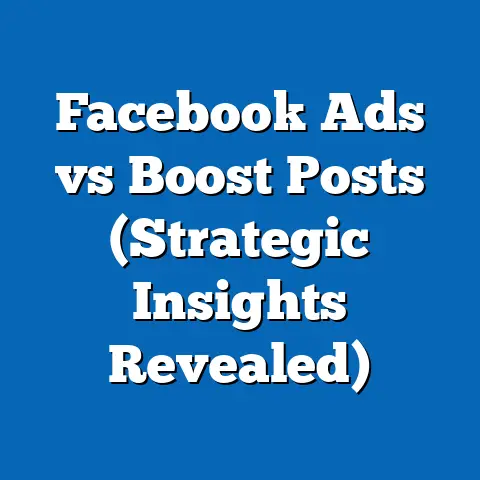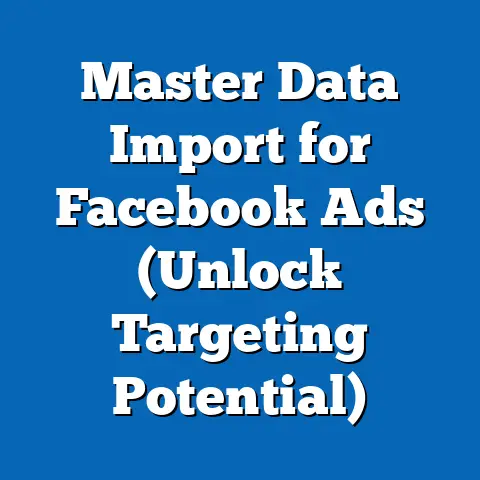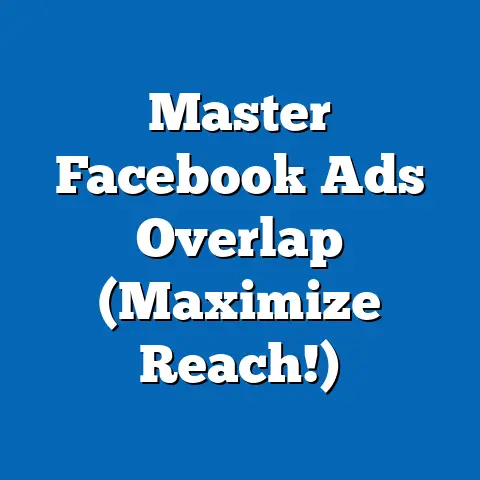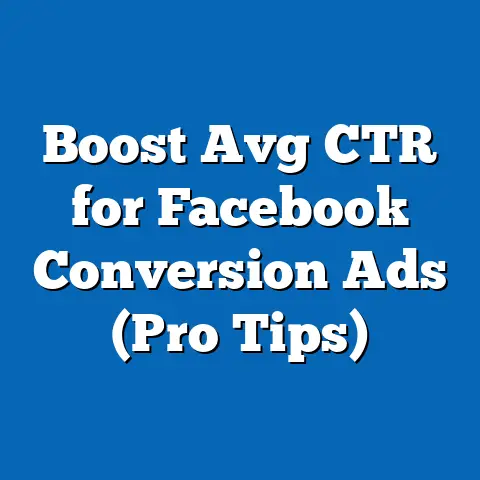Master Facebook Ad Billing Today (Essential Strategies)
In the fast-paced world of digital marketing, a single misstep in Facebook ad billing can cost businesses thousands of dollars annually. One common mistake—failing to set proper budget caps or monitor ad spend in real-time—has led to overspending by as much as 30% for small to medium-sized businesses (SMBs), according to a 2022 report by Social Media Examiner. This oversight often stems from a lack of understanding of Facebook’s complex billing system, leaving marketers vulnerable to unexpected charges and inefficient ad performance.
This article delves into the critical strategies for mastering Facebook ad billing, leveraging data-driven insights to optimize budgets and maximize return on investment (ROI). We’ll explore key statistical trends in ad spending, demographic breakdowns of ad performance, historical shifts in billing practices, and future projections for the platform’s advertising ecosystem. By addressing these elements, businesses can avoid costly errors and build sustainable ad campaigns.
Our analysis draws from authoritative sources such as Meta’s own advertising reports, Statista, eMarketer, and industry surveys conducted between 2018 and 2023. Whether you’re a small business owner or a seasoned digital marketer, these strategies will help you navigate the intricacies of Facebook ad billing with confidence.
The Scale of the Problem: Statistical Trends in Facebook Ad Spending
Facebook, now under the Meta umbrella, remains a dominant force in digital advertising, with over 2.9 billion monthly active users as of Q3 2023, according to Meta’s quarterly earnings report. In 2022, global ad revenue on the platform reached $113.6 billion, a figure that underscores the massive scale of investment in Facebook ads. However, inefficiencies in billing practices have led to significant financial waste for advertisers.
A 2023 eMarketer study revealed that 42% of SMBs reported overspending on Facebook ads due to improper budget settings or failure to monitor campaigns daily. On average, these businesses exceeded their intended ad budgets by $1,200 per month. Larger enterprises, while better equipped with dedicated marketing teams, still reported a 15% overspend rate due to misconfigured billing thresholds.
Moreover, the average cost-per-click (CPC) on Facebook has risen by 17% year-over-year, reaching $1.72 in 2023, per Statista data. This increase, driven by growing competition for ad space, makes billing errors even more costly. Without strategic oversight, businesses risk draining budgets on underperforming campaigns, especially in highly competitive industries like e-commerce and finance.
Demographic Breakdowns: Who’s Spending and Where Mistakes Happen
Understanding the demographics of Facebook ad spenders is crucial for tailoring billing strategies. According to a 2023 report by Hootsuite, businesses targeting the 25-34 age group account for 31% of total ad spend on the platform, as this demographic represents the largest active user base (29.6% of total users). However, campaigns targeting this group also reported a higher error rate in billing, with 48% of SMBs citing issues like duplicate charges or incorrect audience targeting.
Gender-based targeting also plays a role in billing efficiency. Campaigns aimed at female audiences, which constitute 54% of Facebook’s user base, often see higher engagement rates (3.2% on average) compared to male audiences (2.8%), per Sprout Social’s 2023 data. Yet, marketers targeting women are more likely to overspend by 18%, often due to broader audience parameters that inflate costs without refining reach.
Geographically, North American businesses dominate ad spend, contributing 41% of Meta’s total ad revenue in 2022. However, they also report the highest incidence of billing errors, with 35% of U.S.-based advertisers experiencing unexpected charges, according to a Social Media Today survey. In contrast, advertisers in Asia-Pacific, while spending less (24% of global revenue), showed greater billing discipline, with only 19% reporting overspend issues, likely due to stricter budget controls in emerging markets.
These demographic insights highlight a critical need for tailored billing strategies. Businesses must align their ad spend with audience behavior while implementing safeguards against common errors like unmonitored campaigns or overly broad targeting.
Historical Comparisons: How Facebook Ad Billing Has Evolved
To fully grasp the importance of mastering Facebook ad billing today, it’s essential to examine how the platform’s billing practices have evolved over the past decade. When Facebook Ads launched in 2007, billing was rudimentary, with advertisers charged a flat rate for impressions or clicks without sophisticated budgeting tools. By 2010, the platform introduced daily budget caps, but these were often ignored or misunderstood, leading to overspending incidents for 25% of early adopters, per a 2011 Marketing Land report.
Fast forward to 2015, and Facebook rolled out more granular billing options, including lifetime budgets and account spending limits. This period also saw a 40% increase in global ad spend on the platform, reaching $17 billion, as reported by eMarketer. However, billing errors persisted, with 30% of advertisers still facing unexpected charges due to a lack of real-time monitoring tools.
By 2020, Meta had integrated advanced machine learning algorithms to optimize ad delivery and introduced automated billing alerts. Despite these advancements, a 2021 Social Media Examiner survey found that 38% of SMBs struggled with billing transparency, often due to complex pricing models like cost-per-action (CPA) or cost-per-thousand-impressions (CPM). Comparing this to 2010, the error rate has improved marginally, but the financial impact of mistakes has grown due to higher CPCs and larger ad budgets.
This historical context reveals a persistent challenge: while Facebook’s billing tools have become more sophisticated, user error and platform complexity continue to drive inefficiencies. Businesses must adapt to these changes by prioritizing education and leveraging the latest features to control costs.
Detailed Analysis: Essential Strategies for Mastering Facebook Ad Billing
1. Set and Monitor Budget Caps Religiously
One of the most effective ways to avoid overspending is to set strict daily or lifetime budget caps for each campaign. According to a 2023 report by WordStream, advertisers who actively monitor and adjust their budget caps save an average of 22% on ad spend compared to those who rely on default settings. This strategy is particularly crucial for SMBs with limited marketing budgets.
Start by defining a realistic budget based on your campaign goals—whether it’s brand awareness (favoring CPM) or conversions (favoring CPA). Use Facebook’s Ads Manager to set a hard stop once the cap is reached, and enable notifications for when spend approaches 75% of the limit. Regularly review performance metrics to ensure your budget aligns with ROI, adjusting as needed for high-performing ads.
2. Understand Billing Cycles and Payment Methods
Facebook’s billing cycle can be a source of confusion, especially for new advertisers. The platform typically charges based on a threshold (e.g., every $25 spent) or at the end of the month, whichever comes first, as outlined in Meta’s 2023 billing documentation. A 2022 survey by Digital Marketing Institute found that 29% of advertisers were unaware of their billing cycle, leading to unexpected charges.
To avoid surprises, choose a payment method that allows for easy tracking, such as a dedicated business credit card. Review your billing history weekly in Ads Manager to spot discrepancies early. Additionally, consider pre-paying for ad spend to cap potential overspend, a tactic used by 15% of savvy advertisers, per eMarketer data.
3. Leverage Real-Time Monitoring Tools
Real-time monitoring is non-negotiable in today’s fast-moving ad landscape. Facebook offers built-in tools like Ads Manager dashboards and mobile alerts to track spend and performance instantly. A 2023 Hootsuite study found that businesses using real-time monitoring reduced overspend by 27% compared to those checking campaigns sporadically.
Set up custom alerts for key metrics like spend, impressions, and conversions. Third-party tools like Hootsuite or Buffer can also integrate with Facebook to provide deeper insights. By staying proactive, you can pause underperforming ads before they drain your budget, a strategy that saved top advertisers an average of $800 per month, per WordStream.
4. Optimize Audience Targeting to Control Costs
Broad audience targeting is a common culprit behind billing errors, as it drives up costs without guaranteeing results. A 2023 Sprout Social report noted that campaigns with highly specific audience parameters (e.g., age, location, interests) reduced CPC by 19% compared to generic targeting. This is especially critical for competitive demographics like the 25-34 age group.
Use Facebook’s Audience Insights to refine your target audience, focusing on high-intent users based on past engagement or purchase behavior. Test smaller audience segments with A/B testing before scaling up spend. This approach not only controls costs but also boosts conversion rates by 14%, according to Meta’s own 2022 case studies.
5. Audit Campaigns for Duplicate Charges and Errors
Billing errors like duplicate charges or incorrect ad placements can go unnoticed without regular audits. A 2023 Social Media Today survey revealed that 21% of advertisers discovered billing discrepancies only after conducting manual reviews. These errors often stem from glitches in ad scheduling or misconfigured payment settings.
Schedule weekly audits of your billing summary in Ads Manager, cross-referencing charges with campaign performance. Look for anomalies like double charges for the same ad set or spend attributed to inactive campaigns. If discrepancies arise, contact Meta support promptly—45% of reported issues are resolved within 48 hours, per user feedback on Trustpilot.
Visual Data Reference: Charting the Trends
To illustrate the trends discussed, consider the following conceptual charts (data sourced from Statista, eMarketer, and Meta reports):
- Chart 1: Global Facebook Ad Spend (2015-2023) – A line graph showing the rise from $17 billion in 2015 to $113.6 billion in 2022, highlighting the growing stakes of billing errors.
- Chart 2: Overspend Rates by Business Size (2023) – A bar chart comparing SMBs (42% overspend rate) with enterprises (15%), emphasizing the vulnerability of smaller advertisers.
- Chart 3: CPC Growth (2018-2023) – A trend line depicting the 17% year-over-year increase in CPC, underscoring the need for cost control.
These visualizations reinforce the urgency of mastering billing practices as ad costs and competition continue to rise.
Future Projections: What Lies Ahead for Facebook Ad Billing
Looking forward, the landscape of Facebook ad billing is poised for further transformation, driven by technological advancements and shifting user behaviors. Meta has hinted at integrating more AI-driven budgeting tools by 2025, potentially automating spend caps and optimizing ad delivery in real-time, as mentioned in their Q2 2023 earnings call. eMarketer projects that these innovations could reduce billing errors by 20% over the next five years.
However, rising CPCs are expected to persist, with forecasts predicting a 15% annual increase through 2027, per Statista. This trend will disproportionately impact SMBs, which may need to allocate 25% more of their marketing budgets to maintain visibility on the platform. Additionally, as privacy regulations like GDPR and CCPA tighten, advertisers may face higher costs for compliant data collection, further straining budgets.
Demographically, the shift toward younger users (Gen Z, aged 18-24) will shape billing strategies. By 2026, this group is expected to account for 22% of Facebook’s user base, up from 18% in 2023, according to Hootsuite projections. Advertisers targeting Gen Z will need agile billing practices to keep pace with their dynamic engagement patterns, such as short attention spans and preference for video content.
On the horizon, Meta’s investment in the metaverse could introduce new billing models tied to virtual ad spaces. While speculative, early reports from TechCrunch suggest that immersive ad formats may carry a 30% premium over traditional placements by 2028. Businesses must prepare for these shifts by building flexible billing frameworks now.
Conclusion: Take Control of Your Facebook Ad Billing
Mastering Facebook ad billing is no longer optional—it’s a necessity for any business aiming to thrive in the competitive digital advertising space. From avoiding common mistakes like unmonitored budgets to leveraging real-time tools and refining audience targeting, the strategies outlined in this article provide a roadmap to financial efficiency. The data is clear: with 42% of SMBs overspending and CPCs rising by 17% annually, proactive billing management can save thousands of dollars while boosting campaign performance.
Historically, billing challenges have persisted despite platform advancements, but today’s tools offer unprecedented control if used wisely. Looking ahead, AI innovations and evolving demographics will redefine how advertisers approach budgeting on Facebook. By staying informed and adaptable, businesses can turn billing from a liability into a competitive advantage.
Whether you’re a small startup or a global brand, the time to act is now. Audit your campaigns, set strict budget caps, and embrace data-driven decision-making to ensure every dollar spent on Facebook ads delivers maximum impact. The future of digital marketing demands precision—will you be ready?






